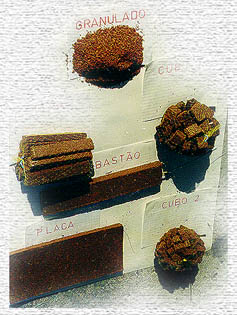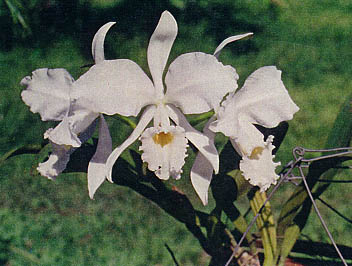

THE COXIM POTTING MEDIUM
Augusto Burle Gomes Ferreira (Coxim inventor and producer)
In the eighties, when I first noticed an excessive increase in the price of tree fern fibers (xaxim) due to the fact of it was on the way to extinction, I turned to the cultivation of epiphytes in coconut bark, which is a century old traditional custom in the Northeast of Brazil.
I sought to find a technique to reaggregate the parenchymatous tissue of coconut, something held as impossible by science (reaggreation by pectin, in this vegetal tissue), for it is in this tissue that plants seek their nourishment, and not in the fibers which have no use for cultivation,.
Once having mastered this technique, two ecological problems would be solved: the preservation of the species of Dicksonia selowii and the mangrove bushes and lagoons of the Northeast.
These are constantly being destroyed by the massive discharge of the parenchymatous tissue of the coconut by the unraveling machines.
Besides, it would still give the product the most convenient form for its utilization.
 The small plants of the palm at first make their roots in its own bark, and after pass into the soil. The coconut bark is a nutrient produced by the coconut tree to nourish its offspring, in the first phase of their growth.
The small plants of the palm at first make their roots in its own bark, and after pass into the soil. The coconut bark is a nutrient produced by the coconut tree to nourish its offspring, in the first phase of their growth.
I even dare call it &vegetal milk".
This suggests that its high nutritive value does not depend on the tissue decay which is proved by culture on coxim.
It may be noted that the coconut bark when thrown on the field, will only decay totally after an eight year period.
Coxim is semi-industrialized product from the parenchymatous tissue of the coconut bark. It is good not only for the epiphytes but also for terrestrial plants.
The qualities worth mentioning in coxim are:
1- Auto-stabilizing of pH
According to the measurements made by the Department of Chemistry of The Federal University of Pernambuco during five years, the following averages were found:
|
New | pH 5,53 |
|
1 year use | pH 5,72 |
|
3 year use | pH 5,18 |
|
4 year use | pH 5,35 |
|
5 year use | pH 5,25 |
which shows in it an anomalous behavior for organic matter. Usually organic matter in the decaying process, becomes alkaline, while coxim preserves its acidity on a proper level for orchids.
2- Richness of Nutrients
Analysis made on ashes, by the laboratory at Superintendência do Desenvolvimento do Nordeste (SUDENE), found the following contents of non volatile elements:
|
Potassium as K2O | 0,722% |
|
Calcium as CaO | 0,439% |
|
Magnesium as Mgo | 0,234% |
|
Phosphorus as P2O5 | 0,196% |
|
Iron as Fe2O3 | 0,130% |
|
Zinc as Zn | 0,0029% |
|
Copper as CuO | 0,0025% |
|
Mangases as MnO | 0,0020% |
|
Boron as B | trace |
And analysis to determine N - P - K concentration made by Instituto Tecnológico de Pernambuco had the following results:
|
Nitrogen as N | 0,46% |
|
Phosphorus as P2O5 | 0,26% |
|
Potassium as K | 1,39% |
These results show only a lack of molybdenum and cobalt among micro-nutrients and a slightly low content of nitrogen. However, the analysis made by Prof. Milton Leinig from the Federal University of Paraná presented traced of cobalt.
I fertilize my orchids once a year with a mixture of castor bean cake and bone meal to complement nitrogen, plus Peter 20-20-20 to assure the extension of all nutrients so I can declare that cultivation in coxim is a low fertilizer consumption one. I should add that it is rich in silicon which is a catalyst of the absorption of the other plants nutrients.
3- Production of Micorriza rich environment
Spontaneous seedling of several genera (Dendrobium, Thunia, Epidendrum, Cattleya Caularthron, Phajus, Acample, etc.) budding from other orchids baskets. Other coxim users have the same occurrence in their nurseries. I don't remove the pods that appear naturally after flowering. By this, I don't mean that coxim is a cultivation media for commercial germination; I only noticed that with its use the greenhouse becomes an environment rich in micorriza fungi.
 |
| Cattleya labiata oramaena 'Vaninha'. |
4- Lesser need for watering
coxim being a spongy tissue, it is highly absorbent. It may even absorb 200% of its weight in water. It also has the property, when in pots, of having its outer layer isolating the evaporation of the inner ones. So, its need of watering is smaller than that of several potting media.
It must be noted that in this case the pot must never be totally dry: in opposition to other potting media, water does not significantly accelerate its decay.
5- Great durability
The durability of coxim, compared to other organic potting media, is quite great, in the equatorial climate of Recife, with great humidity (55% minimum, 98% maximum) its average durability is 4 years. In other climatic conditions it may last up to 8 years.
6- Sterilized products
The coconut bark naturally contains a lot of tannin, a substance that is a powerful bactericide and fungicide. Besides, coxim is pasteurized in its manufacture: it is slowly heated (7 hours) up to 80oC and remains at this temperature at least for 4 hours, being maintained at a 21kg/cm² pressure. As a result, I am sure I can provide the clients with a potting medium free from bacteria and fungi.
7- Easy handling
It is an easy-to-handle potting medium, after you get used to it. Besides, There is no case of allergic reactions known at this moment.
However, as nothing is perfect, coxim also has a few inconveniences and you have to learn how to deal with.
1- It needs some fertilizing
Its nitrogen content could be greater. This was minimized by the production of coxim E (enriched) which receives l,5% of castor bean cake and bone meal; but his is a product that I manufacture in a smaller scale.
2- Its volume varies
On absorbing water, coxim increases it volume in 7% (average) and upon drying it returns to its original volume. That is why the cubes should be placed in an irregular way. This does not affect the roots.
3- It needs washing
Washing before using is indispensable to remove the tannin, or else it will burn all new roots for about three months. Tannin, which protects it from leading pathogenic agents, is also a powerful herbicide.
We recommend that it be immersed in water for 4 days for the granulated formula, 8 days for the cubes and strips and 15 days for the plates and rods. Those who have the facilities may test for tannin adding a littler water from the washing to a solution of lead acetate 1%. However it may be kept when wet for a long time (up to 6 months) to be used according to needs, not presenting any decay.
4- It brings weeds to the greenhouse
Greenhouses planted with coxim start having trouble with weeds. Any seed that falls upon it will germinate: from moss to trees.
5- It needs a change of habits
The orchid hobbyist must be willing to learn how to plant in coxim because each potting medium has its own requirements.
To finish this, I shall read the conclusion of the Associate Professorship thesis of Prof. Esmeralda Payão Dematté, of the Horticultural Department of the Faculdade de Ciências Agrárias de Jaboticabal, Federal University of São Paulo (UNESP) "...among the potting media studied, pure coxim is the one that holds the most qualities to replace tree fern".
Text extract from the Associate Professorship thesis of Prof. Esmeralda Payão Dematée, of the Horticultural Department of the Faculdade de Ciências Agrárias de Jaboticabal, Federal University of São Paulo (UNESP) (1992)



 Back to Orchid News Back to Orchid News | Stay at the Forum
 |
 The small plants of the palm at first make their roots in its own bark, and after pass into the soil. The coconut bark is a nutrient produced by the coconut tree to nourish its offspring, in the first phase of their growth.
The small plants of the palm at first make their roots in its own bark, and after pass into the soil. The coconut bark is a nutrient produced by the coconut tree to nourish its offspring, in the first phase of their growth.




